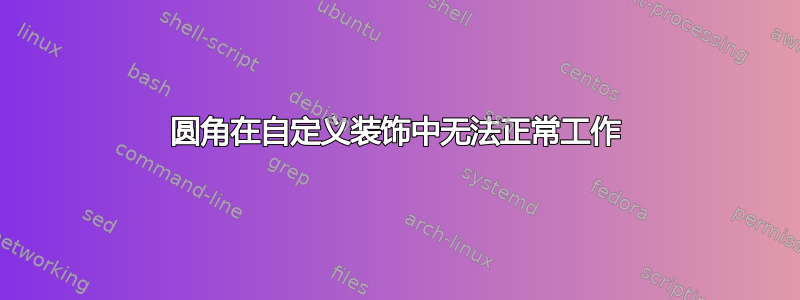
我想用 TikZ 创建一些化学路易斯结构 - 我不能使用chemfig它因为我需要根据它们的坐标绘制原子 - 并且需要定义一些自定义键类型,例如楔形键和虚线楔形键。装饰似乎是做到这一点的自然方式(如果有人知道更好的方法,我愿意接受建议)并设法使一些东西工作。我这样做是为了让键被一些白色空间包围,以便使其在两个键可能重叠的情况下看起来正确(我将白色空间涂成蓝色以使其在我的示例代码中可见)。为了让它看起来更漂亮一点,我想使用圆角,但不幸的是这些似乎在我的装饰中无法正常工作。我怎样才能让圆角工作?
\documentclass{standalone}
\usepackage{tikz}
\usetikzlibrary{decorations}
\begin{document}
\begin{tikzpicture}
\newlength{\dashedwedgelen}
\setlength{\dashedwedgelen}{5pt}
\newlength{\wedgeheight}
\setlength{\wedgeheight}{2.5pt}
\pgfmathsetmacro\startheight{\wedgeheight/5}
\pgfmathsetmacro\whitespace{\wedgeheight/2}
\pgfmathsetmacro\dashgapratio{0.3}
\pgfdeclaredecoration{dashed wedge}{initial}
{
\state{initial}[
width=0.0,
persistent precomputation={
\pgfmathsetmacro\dashseglen{(\pgfdecoratedpathlength - \dashgapratio*\dashedwedgelen) / floor((\pgfdecoratedpathlength - \dashgapratio*\dashedwedgelen)/\dashedwedgelen)}},
next state=body
]
{
% surrounding white space
\color{blue}
\pgfpathmoveto{\pgfpoint{0}{\startheight + \whitespace}}
\pgfpathlineto{\pgfpoint{\pgfdecoratedpathlength}{\wedgeheight + \whitespace}}
\pgfpathlineto{\pgfpoint{\pgfdecoratedpathlength}{-(\wedgeheight + \whitespace)}}
\pgfpathlineto{\pgfpoint{0}{-(\startheight + \whitespace)}}
\pgfpathlineto{\pgfpoint{0}{\startheight + \whitespace}}
\pgfclosepath
\pgfusepath{fill, stroke}
\pgfpathmoveto{\pgfpointdecoratedinputsegmentlast}
}
\state{body}[width=\dashseglen]
{
% computations
\pgfmathsetmacro\segwidth{\dashgapratio*\dashseglen}
\pgfmathsetmacro\segstartheight{\startheight + (\wedgeheight - \startheight)*(\pgfdecoratedcompleteddistance) / \pgfdecoratedpathlength}
\pgfmathsetmacro\segendheight{\startheight + (\wedgeheight - \startheight)*(\pgfdecoratedcompleteddistance + \dashgapratio*\dashseglen) / \pgfdecoratedpathlength}
% drawing
\pgfpathmoveto{\pgfpoint{0}{\segstartheight}}
\pgfpathlineto{\pgfpoint{\segwidth}{\segendheight}}
\pgfpathlineto{\pgfpoint{\segwidth}{-\segendheight}}
\pgfpathlineto{\pgfpoint{0}{-\segstartheight}}
\pgfpathlineto{\pgfpoint{0}{\segstartheight}}
\pgfpathclose
}
\state{final}
{
% computations
\pgfmathsetmacro\segwidth{\dashgapratio*\dashseglen}
\pgfmathsetmacro\segstartheight{\startheight + (\wedgeheight - \startheight)*(\pgfdecoratedcompleteddistance) / \pgfdecoratedpathlength}
\pgfmathsetmacro\segendheight{\startheight + (\wedgeheight - \startheight)*(\pgfdecoratedcompleteddistance + \dashgapratio*\dashseglen) / \pgfdecoratedpathlength}
% drawing
\pgfpathmoveto{\pgfpoint{0}{\segstartheight}}
\pgfpathlineto{\pgfpoint{\segwidth}{\segendheight}}
\pgfpathlineto{\pgfpoint{\segwidth}{-\segendheight}}
\pgfpathlineto{\pgfpoint{0}{-\segstartheight}}
\pgfpathlineto{\pgfpoint{0}{\segstartheight}}
\pgfpathclose
\pgfmoveto{\pgfpointdecoratedpathlast}
}
}
\node (x) at (0,0) [rectangle, rounded corners=0.8mm, fill = blue, inner sep=0.1mm, scale=2.5] {Ti};
\node (y) at (1.5,0.) [rectangle, rounded corners=0.8mm, fill = blue, inner sep=0.1mm, scale=2.5] {L};
\fill [red, decorate, decoration=dashed wedge, rounded corners=0.5pt] (x) -- (y);
\end{tikzpicture}
\end{document}

答案1
问题在于您明确地绘制了一条线并关闭了路径。如果您删除\pgfpathlineto每个之前的\pgfclosepath,则问题就消失了。
还可以通过使用\pgfqpoint(不使用数学解析器)和\pgfmathsetlengthmacro(确保存储在宏中的解析表达式以 结尾pt)使代码更加高效。
\documentclass{standalone}
\usepackage{tikz}
\usetikzlibrary{decorations}
\begin{document}
\begin{tikzpicture}
\newlength{\dashedwedgelen}
\setlength{\dashedwedgelen}{5pt}
\newlength{\wedgeheight}
\setlength{\wedgeheight}{2.5pt}
\pgfmathsetmacro\startheight{\wedgeheight/5}
\pgfmathsetmacro\whitespace{\wedgeheight/2}
\pgfmathsetmacro\dashgapratio{0.3}
\pgfdeclaredecoration{dashed wedge}{initial}
{
\state{initial}[
width=0.0,
persistent precomputation={
\pgfmathsetmacro\dashseglen{(\pgfdecoratedpathlength - \dashgapratio*\dashedwedgelen) / floor((\pgfdecoratedpathlength - \dashgapratio*\dashedwedgelen)/\dashedwedgelen)}%
%
\pgfmathsetlengthmacro\wedgeheight{\wedgeheight}%
\pgfmathsetlengthmacro\startheight{\startheight}%
\pgfmathsetlengthmacro\whitespace{\whitespace}%
},
next state=body
]
{
% surrounding white space
\pgfmathsetlengthmacro\beginheight{\startheight+\whitespace}
\pgfmathsetlengthmacro\endheight{\wedgeheight + \whitespace}
\pgfpathmoveto{\pgfqpoint{0pt}{\beginheight}}
\pgfpathlineto{\pgfqpoint{\pgfdecoratedpathlength}{\endheight}}
\pgfpathlineto{\pgfqpoint{\pgfdecoratedpathlength}{-\endheight}}
\pgfpathlineto{\pgfqpoint{0pt}{-\beginheight}}
\pgfclosepath
\pgfsetfillcolor{blue}
\pgfsetstrokecolor{blue}
\pgfusepath{fill, stroke}
}
\state{body}[width=\dashseglen]
{
% computations
\pgfmathsetlengthmacro\segwidth{\dashgapratio*\dashseglen}
\pgfmathsetlengthmacro\segstartheight{\startheight + (\wedgeheight - \startheight)*(\pgfdecoratedcompleteddistance) / \pgfdecoratedpathlength}
\pgfmathsetlengthmacro\segendheight{\startheight + (\wedgeheight - \startheight)*(\pgfdecoratedcompleteddistance + \dashgapratio*\dashseglen) / \pgfdecoratedpathlength}
% drawing
\pgfpathmoveto{\pgfqpoint{0pt}{\segstartheight}}
\pgfpathlineto{\pgfqpoint{\segwidth}{\segendheight}}
\pgfpathlineto{\pgfqpoint{\segwidth}{-\segendheight}}
\pgfpathlineto{\pgfqpoint{0pt}{-\segstartheight}}
\pgfpathclose
}
\state{final}
{
% computations
\pgfmathsetlengthmacro\segwidth{\dashgapratio*\dashseglen}
\pgfmathsetlengthmacro\segstartheight{\startheight + (\wedgeheight - \startheight)*(\pgfdecoratedcompleteddistance) / \pgfdecoratedpathlength}
\pgfmathsetlengthmacro\segendheight{\startheight + (\wedgeheight - \startheight)*(\pgfdecoratedcompleteddistance + \dashgapratio*\dashseglen) / \pgfdecoratedpathlength}
% drawing
\pgfpathmoveto{\pgfqpoint{0pt}{\segstartheight}}
\pgfpathlineto{\pgfqpoint{\segwidth}{\segendheight}}
\pgfpathlineto{\pgfqpoint{\segwidth}{-\segendheight}}
\pgfpathlineto{\pgfqpoint{0pt}{-\segstartheight}}
\pgfpathclose
}
}
\node (x) at (0,0) [rectangle, rounded corners=0.8mm, fill = blue, inner sep=0.1mm, scale=2.5] {Ti};
\node (y) at (1.5,0.) [rectangle, rounded corners=0.8mm, fill = blue, inner sep=0.1mm, scale=2.5] {L};
\fill [red, decorate, decoration=dashed wedge, rounded corners=0.5pt] (x) -- (y);
\end{tikzpicture}
\end{document}



